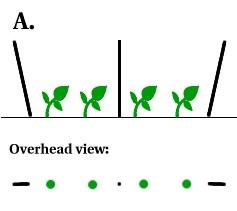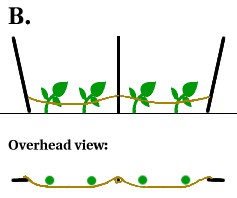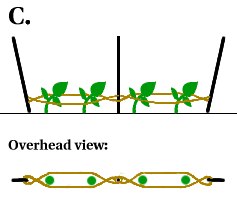How Do I Use Florida Weave?
Florida Weave is without a doubt the best support method I've found for tomatoes (and a couple of other things). If you do a search, you'll find some descriptions out there, but few of them go into enough detail to do more then confuse. I hope this description is a little more thorough.
The basic idea is to make a row of tomatoes, held upright between lines of heavy twine. It's what a lot of commercial growers use, because it's fast, easy to set up and maintain, and very effective. And once you have the basic idea, it's easy even for a novice.
What you'll need is several sturdy stakes and a large ball of durable twine. I use the fenceposts commonly used for standard yard fencing, called T-posts (their cross-section gives them the name), available at any hardware store for a dollar and a half apiece; as for how many, take the number of plants in the row, divide the number in half, and add one. So for six plants, you'll need half of six (3) plus one (4) posts.

A. Space the tomatoes as you normally would; I use three feet apart, but I've known people to do it as close as 18 inches in excellent soil. Drive one stake for every two tomatoes, with stakes on the end. Angle the end stakes outward to take the weight.

B. Using heavy twine, tie a line about 8-10" above ground level on an end stake. Run the line on one side of the next two tomato plants (the front side), then to the back side of the post; take a turn around the post, and run on the front side of the next two plants. Pull it as tight as you can.

C. When you get to the end, return the opposite way: the back side of the plants, the front side of the posts. This pulls each line in toward the center, sandwiching the plants; if you don't "weave" it this way, the plants will tend to lean out more.
Run lines every 8-10" high as the plants grow, and tuck new vines in every few days. No pruning is necessary, though I tend to prune shoots below the first line of twine to keep things a little neater around ground level. As the season progresses, the twine will stretch a little, so be prepared to take up the slack in some way -- many people take a small stick and "tourniquet" the line to keep it taut.
Even if you fall behind a bit (who doesn't?) all is not lost. If the plants have grown a foot above the last line, add another line and wrestle all the growth into the top line, then start tucking farther down. The vines don't have to be inside every line, just enough of them to keep the plant from flopping around. As time goes on, you may very well run out of pole, too; just let them fold over somewhere past the top, then begin tucking them into the weave wherever they come down. You'll have a wall of foliage by season's end, but that was sort of the idea.
I haven't come upon a real deal-breaker with this method yet. It's cheap, as you can recycle posts (you can even find used ones sometimes, and save having to buy them) and all you need every season is twine; it's easy to store, since you can compost the twine and stack the posts. The plants grow up off the ground and fruit is easy to find and pick, but there's enough foliage to prevent sunscald. The most irritating thing is keeping the lines taut, but even that gets more routine with practice, and it's an occasional task, not constant.
All in all, I prefer it to the common alternatives of staking or using cages made of concrete reinforcing wire. If you have any questions, drop me a line.